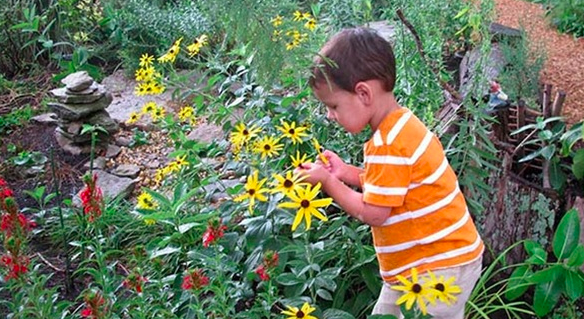CHAPP targets our schoolyard and community center grants based on what we have seen works the best. We’re looking for projects that meet four essential criteria:
- Youth engagement in planning and doing (age-appropriate)
- Creation of an ecosystem community based on native plants that support pollinators (see CHAPP Basics)
- Focus on hands-on educational activities
- Incorporate a maintenance plan that helps ensure the project will be sustained going forward
We emphasize youth engagement because it is the single best predictor of project success. Children of any age can participate in visualizing and planning a project. And of course children of any age can prepare the soil and place plants or seeds. The participation will be different for very young children compared to youth in middle or high school. We will favor an application that shows children’s ideas, drawings and research rather than one that shows the polished work of adults. The engagement of children leads to learning, pride in the project, and continued efforts to establish and continue the project.

Second, we focus on projects with native plants: the foundation of a complex web of life that includes birds, beneficial insects, soil organisms and other creatures. Multiple native plant species provide food, shelter and other habitat services and make the project an interesting place. You can include edible plants if you choose those that are native to your area. If you need assistance with planning your project, perhaps one of our members can help you identify species that are appropriate to your site’s soil, sunlight and moisture conditions, so the plants will thrive. All plant material must be free of pollinator-killing systemic pesticides. Email [email protected] for assistance
Our third essential criterion is a focus on hands-on educational activities. These can cover a wide range of subjects and activities – from biology and ecology to poetry and visual arts. Most successful projects incorporate multiple learning concepts and involve multiple teachers. We prefer to fund these projects. Depending on your situation, you may also find it useful to link your activities to state-mandated curricula.
Finally, and perhaps most importantly, we must see a thoughtful and realistic maintenance plan that draws from the school community of students, teachers and parents. It is unrealistic to expect school grounds or community center maintenance staff to keep the garden functional and aesthetically pleasing. Using native plants can reduce maintenance requirements over time, but new installations must be watered, tended and nurtured for at least the first year and occasionally cleaned, pruned, and revised over time. Water access is often a problem at many installations, and that and maintenance over spring and summer breaks must be specifically addressed.
